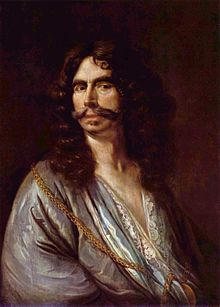Johann Heinrich Roos
- Machine translation, like DeepL or Google Translate, is a useful starting point for translations, but translators must revise errors as necessary and confirm that the translation is accurate, rather than simply copy-pasting machine-translated text into the English Wikipedia.
- Consider adding a topic to this template: there are already 9,161 articles in the main category, and specifying
|topic=will aid in categorization. - Do not translate text that appears unreliable or low-quality. If possible, verify the text with references provided in the foreign-language article.
- You must provide copyright attribution in the edit summary accompanying your translation by providing an interlanguage link to the source of your translation. A model attribution edit summary is
Content in this edit is translated from the existing German Wikipedia article at [[:de:Johann Heinrich Roos]]; see its history for attribution. - You may also add the template
{{Translated|de|Johann Heinrich Roos}}to the talk page. - For more guidance, see Wikipedia:Translation.
Johann Heinrich Roos | |
|---|---|
 Self-portrait, 1682 | |
| Born | (1631-09-29)29 September 1631 Otterberg |
| Died | 3 October 1685(1685-10-03) (aged 54) Frankfurt |
| Known for | Painting |
| Movement | Baroque |

Johann Heinrich Roos (29 September 1631, Otterberg – 3 October 1685, Frankfurt) was a German Baroque era landscape painter and etcher.
Biography
Roos was born in Otterberg, a town in the Palatinate in 1631. His family had emigrated to Amsterdam due to the Thirty Years' War in 1640.[1] He trained with Guilliam du Gardijn,[2] Cornelis de Bie[1] and Barent Graat,[1] but the landscape painters Nicolaes Berchem and Karel Dujardin were more of an influence on him. In 1653 the Roos family returned to Germany, where Johann and his brother Theodor Roos worked together on a commission for a cloister in Mainz.
Between 1654 and 1659, Johann worked for Ernst, Landgrave of Hesse-Rheinfels (son of Maurice, lived 1623–1693), where he painted a portrait of A Prince (1654, Heidelberg, Kurpfälzisches Museum) and religious scenes. In 1664 he was invited to paint at the court of Charles I Louis, Elector Palatine.[1] Due to unsatisfactory working conditions, he moved with his family to Frankfurt in 1667 and was very successful, but lost everything in a fire in 1685. He died trying to save his belongings. Four sons and a daughter survived to become good painters.[1]
Though not registered as a pupil of Rembrandt, he made a copy of a painting by Rembrandt that he saw presumably in Amsterdam while he trained there from 1647 to 1653:
-
 by Roos
by Roos -

Works

Roos specialized in pastoral idylls, idealized landscapes with ancient ruins. He found inspiration in engravings. These pastoral scenes represent the longing of Roos for harmony between men and animals with nature. Among biblical, historical and genre scenes, Roos preferred subjects involving animals: the shepherds of the nativity, Venus and Adonis. Roos was also one of the finest German portrait painters of his time. He painted princes, noble ladies and officers, but also Frankfurt middle classes. Roos worked too from many individual drawings (Albertina, Vienna), mostly of domestic animals. He intensified the individuality of each species.
Gallery of animals (ca. 1668–1670)
Public collections
Roos is represented in the following collections : Kunsthistorisches Museum, Vienna; Städelsches Kunstinstitut, Frankfurt; Allen Memorial Art Museum, Oberlin, Ohio; Fine Arts Museum of San Francisco; Detroit Institute of Arts, Michigan; Dulwich Picture Gallery, London; Crocker Art Museum, California; Indianapolis Museum of Art, Indiana; Dallas Museum of Art, Texas; Palazzo Bianco, Genoa, amongst others.
Family
His sons Philipp Peter Roos (Rosa di Tivoli) and Johann Melchior Roos were also renowned painters. Their works are represented in museums at Frankfurt, Cologne, Dessau, Darmstadt and Stuttgart.[3]
Roos family tree | ||||||||||||||||||||||||||||||||||||||||||||||||||||||||||||||||||||||||||||||||||||||||||||||||||||||||||||||||||||||||||||||||||||||||||||||||||||||||||||||||||||||||||||||||||||||||||||||||||||||||||||||||||||||||||||||||||||||||||||||||||||||||||||||||||||||||||||||||||||
|---|---|---|---|---|---|---|---|---|---|---|---|---|---|---|---|---|---|---|---|---|---|---|---|---|---|---|---|---|---|---|---|---|---|---|---|---|---|---|---|---|---|---|---|---|---|---|---|---|---|---|---|---|---|---|---|---|---|---|---|---|---|---|---|---|---|---|---|---|---|---|---|---|---|---|---|---|---|---|---|---|---|---|---|---|---|---|---|---|---|---|---|---|---|---|---|---|---|---|---|---|---|---|---|---|---|---|---|---|---|---|---|---|---|---|---|---|---|---|---|---|---|---|---|---|---|---|---|---|---|---|---|---|---|---|---|---|---|---|---|---|---|---|---|---|---|---|---|---|---|---|---|---|---|---|---|---|---|---|---|---|---|---|---|---|---|---|---|---|---|---|---|---|---|---|---|---|---|---|---|---|---|---|---|---|---|---|---|---|---|---|---|---|---|---|---|---|---|---|---|---|---|---|---|---|---|---|---|---|---|---|---|---|---|---|---|---|---|---|---|---|---|---|---|---|---|---|---|---|---|---|---|---|---|---|---|---|---|---|---|---|---|---|---|---|---|---|---|---|---|---|---|---|---|---|---|---|---|---|---|---|---|---|---|---|---|---|---|---|---|---|---|---|---|---|---|---|
| ||||||||||||||||||||||||||||||||||||||||||||||||||||||||||||||||||||||||||||||||||||||||||||||||||||||||||||||||||||||||||||||||||||||||||||||||||||||||||||||||||||||||||||||||||||||||||||||||||||||||||||||||||||||||||||||||||||||||||||||||||||||||||||||||||||||||||||||||||||
Notes
- ^ a b c d e (in Dutch) Johan Henrik Roos biography in De groote schouburgh der Nederlantsche konstschilders en schilderessen (1718) by Arnold Houbraken, courtesy of the Digital library for Dutch literature
- ^ Johann Heinrich Roos in the RKD
- ^ Gilman, D. C.; Peck, H. T.; Colby, F. M., eds. (1905). "Roos, Johann Heinrich" . New International Encyclopedia (1st ed.). New York: Dodd, Mead.
References
- Bolton, Roy (2009). Old Master Paintings & Drawings, London, Sphinx Books, p. 388. ISBN 9781907200014
External links

- Artcyclopedia info
- Columbia Encyclopedia entry
- Roos at the Kunsthistorisches Museum
- Roos at the Fine Arts Museum of San Francisco
- Roos at the Detroit Institute of Arts
- Roos at the Dulwich Picture Gallery
- "Roos, Johann Heinrich" . Encyclopedia Americana. 1920.


















